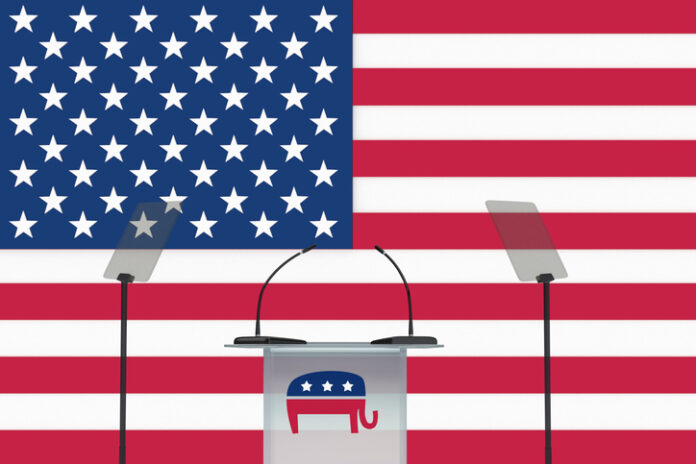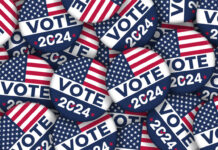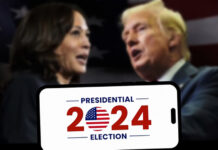By Jack Rasmus
Yesterday’s Vice Presidential debate between Republican J.D. Vance and Democrat Tim Walz might have been called the ‘First Presidential Debate of 2028’. Based on the reasonable debate performances by both, Vance and Walz are clearly now the front runners as presidential candidates for their parties in the next 2028 national election.
Of course, the bar for a reasonable debate was quite low in yesterday’ event, given the poor debate performances by their presidential partners earlier this summer and, for that matter, reaching back as far as the 2016 national elections. TV audiences watching must have been surprised that an actual debate occurred.
Vance and Walz were both reasonably well prepared. They spoke to a number of issues, even if not at a high debating skill level. Noticeably absent in the Walz-Vance debate were the vacuous generalities of presidential candidate Kamala Harris in the preceding presidential debate; or the too oft-repeated zingers and one-liners of Trump that were perhaps more appropriate for outdoor rally venues than one on one debates.
In the Vance-Walz debate factual errors were kept to a relative minimum, unlike the volley of fact-checkable claims made by Trump and Harris in the prior presidential debate, thrown at the viewing audience like a food fight in a high school cafeteria.
So how did each VP candidate perform? Had either succeeded in their objectives in the debate? VP debates are not about convincing significant percentages of still undecided voters to decide to vote for their side. In that they are quite unlike the presidential debates which are, theoretically at least, designed to sway last minute voters.
Vance’s objective in the debate was first and foremost to rehab and repackage Trump. And to reiterate the Republican team’s main themes and messages, perhaps backed up with some facts and figures this time instead of opinions and vague phrases. In both regards Vance’s performance can be said to have succeeded.
Walz’s main objective was to convince the audience that Harris, as current vice-president, had her own program that was not the Biden administration’s. In that goal he may have succeeded with regard to US domestic policy but clearly did not with regard to US foreign policy. Harris foreign policy remains clearly the same as Biden’s, especially with regard to policies toward Russia, China and currently escalating war in the middle east.
Harris thus remains tied to Biden’s war policies and risks experiencing the ‘Hubert Humphrey Effect’ in the election. Lyndon Johnson’s VP during the 1960s and Vietnam War, Humphrey lost the 1968 presidential race by a narrow margin to Richard Nixon largely as a result, many political analysts argue, due to his continuing support for Johnson’s Vietnam war policy during the 1968 election.
Both Vance and Walz came across as actually prepared. Even with a few statistics in hand. Vance’s delivery was composed and his remarks to the point in most cases. He appeared personable—an important characteristic for a good many American voters who, unfortunately, decide based on appearance and personality. Walz was similarly prepared but seemed at times a little overly excitable.
Walz clearly stumbled when asked by moderators of his past trips to and views toward China. He confused travel dates and his reply was unconvincing. His concluding remark as to recent criticisms to his inconsistent explanations in his past views toward China was simply “I mis-spoke on this”.
Vance similarly stumbled when asked by moderators about his recent flip flop in his personal views before 2017 about Trump’s qualifications as president. His reply was he was misled by the mainstream US media, that he came to realize he was “wrong about Trump” and that he “changed his mind” after Trump’s first term accomplishments. Vance failed to raise the critique of Walz about his dates of military service which might have gained some points.
In the first half of the debate Vance prevailed on several points over Walz—on the economy, inflation, and immigration. In the second half, however, Walz appeared to have won points when topics of reproductive rights and housing crisis solutions were discussed.
In his first reply of the night, Vance took his time answering the moderators’ first question by providing an introduction of himself in which he emphasized his working class roots and provided anecdotal examples of some of the typical hardships working class folks—single mom households in particular—have to deal with to make ends meet in 21st century USA. He established his class credentials, an important move perhaps in a campaign focusing on working class households in the key northern swing states of Wisconsin, Michigan, and Pennsylvania. Vance also alluded to his ‘southern’ Appalachia roots, no doubt plugging his southern pedigree to voters in other swing states like Georgia and North Carolina.
Walz attempted the same, claiming to have middle class roots, but did not develop that message as effectively and to the extent Vance did.
Foreign Policy
The first question posed by the moderators addressed foreign policy. And the way it was structured revealed much about the state of the mainstream media and the governing US elites’ biases and politics on foreign issues at present. The moderators posed the question to each candidate: “Would you support a pre-emptive strike against Iran?”
It was a query that might have been written for them by AIPAC itself. A less loaded inquiry might have been: “The conflict in the middle east is escalating toward a region wide war. What are your proposals for de-escalation and bringing peace to the region”? “And how specifically would your proposals differ from the current Biden administration’s to date”? The topic was possibly the most important raised given the extreme war escalation going on in the middle east as the debate took place.
As did their presidential partners, Trump and Harris, the two vice-president candidates competed with answers that challenged the other as to who was more supportive of Israel.
Walz accused Trump of being “fickle” and (ironically) of being “too old” at 80 to conduct a vigorous foreign policy in general and in defense of Israel in particular. In contrast, according to Walz, Harris represented “steady leadership”. But no mention here of any change in current Biden administration’s unqualified support for anything Israel might do.
Vance’s reply to the foreign policy question emphasized that no new war occurred while Trump was president in 2017-20 in contrast to multiple wars under Biden-Harris. He charged Democrats had given Iran $100B with which it has been arming its proxies. Vance added Republicans would not intervene in any way to interfere with whatever Israel decided to do.
Both Vance and Walz and Republicans and Democrats have essentially the same policy toward Israel. Both VP candidates ducked the issue of the current rapid escalation to a regional war in the middle east or the increasing likelihood of the US being sucked into the war in the region in support of Israel and against Iran, the latter of which now appears de facto supported by Russia and perhaps China as well.
Following their exchange on Israel and war in the middle east, not one question was asked by moderators—nor did either candidate say anything throughout the rest of the debate—about the war in Ukraine. Vance did not raise his past comments on the Ukraine war that declared Ukraine must agree to a compromise and negotiations with Russia to end the war; nor did Walz in any way raise a comment of that view. Neither VP candidate mentioned US preparation long term for war with China over Taiwan, or US Biden policy currently ramping up its economic war with that country.
Nor was there a whisper about the rapid rise and expansion of the BRICS and its soon to be announced global alternative financial structure that represents the most serious foreign policy development challenging US global economic interests. It’s as if the US elite and their media don’t have a clue about the crumbling US global economic hegemony now underway—a development that may prove as disastrous to US global dominance as any of the wars.
Climate Change
Both candidates seem to agree on the need to produce more fossil fuels while both advocated more alternative energy as well. Both said they were in favor of clean water and air in the USA.
Vance argued the Biden-Harris team allowed China to take the lead in alternative energy development. He and Trump would relocate that investment back to the US. Walz countered that Biden’s Inflation Reduction Act of 2022 was the biggest investment in alternative energy in the US in history and had already created 200,000 new jobs—a claim that at best might reflect a correlation but cannot be verified by any economic analysis as directly resulting from the IRA.
Both candidates competed in favor of more drilling of natural gas. However, Vance did not take full advantage of Harris’ flip flop on fracking policy as he might have.
Neither candidate replied with specifics to the moderators’ question what would they do to reverse the clearly accelerating trend in global warming. Neither had anything to say about the world having reached the tipping point of 1.5 degree centigrade rise in world temperature already, instead of 2040 as scientists previously forecasted.
Immigration
The immigration issue was next debated. Vance predictably argued, like Trump, that 25 million illegal immigrants have entered the US—millions of whom were criminals, the result of which is a devastating effect on housing shortages and prices, availability of jobs, over-whelming of hospital services. The illegals were largely responsible for illegal drug flows and crime in cities across America, according to Vance. But not a word from Vance about immigrants eating cats in Ohio. Walz countered that Trump blocked the bipartisan immigration bill Congress had negotiated. Indirectly Walz suggested the passing of the bill was all that was needed to resolve the social impact of illegal immigrants.
Now it got more interesting. The moderators noted that now more than 50% of US public supported deportation, so how might they, the candidates in office, actually deport millions of them? Vance ducked the question of the mechanics of deportation. His answer was Biden-Harris had reversed 94 Trump executive orders that had stopped the illegals inflow under Trump and Democrats halted building of Trump’s border wall. Trump policy, per Vance, would be to empower the US border patrol more. Walz’s remarks as to what a Harris policy might do to address the illegal immigrant inflow offered nothing new from Biden’s. Instead he emphasized the humanitarian treatment of immigrants was important. That of course was an indirect statement that Harris-Walz policy might not offer any new solution to illegal immigration and its social impact, apart from passing the stalled immigration bill.
Inflation
It was only well into the first hour of the debate that the moderators asked a question on the economy, a topic which just about every poll shows is has been, and continues to be, voters’ number one issue.
Vance dove into discussing economic issues by emphasizing the 20% plus rise in food prices and 60% rise in housing prices under Biden and how real take home pay (note he didn’t say wages) rose under Trump’s previous administration but barely, if at all, has risen under Biden-Harris. Trump’s tariff proposals, he added, were designed to bring back jobs that have been offshored under Biden-Harris.
On direct economic issues Walz avoided any debate on inflation specifics or countered Vance’s take home pay claims and focused more on topics of housing affordability, child care, and corporate taxes. Instead of pinning him down ad keeping the discussion focused on inflation, however, Vance let him slide. Not once did Vance raise the favorite election debate phrase, invented by Reagan with great effect, ‘are you better off today than you were four years ago’? But then, his team-mate Trump failed to do that as well. Both Vance and Trump too briefly mentioned, and consequently failed to drive home the message, the full negative effect of inflation on households, the #1 issue to voters.
They could have repeated the facts that inflation has plateaued at a level 25-35% above what it was in 2019, depending on sources. That monthly mortgage payments were up 114%. Gasoline at the pump 38%. And various food prices 20-37% over what they were four years ago. Walz did not go there either apart from admitting inflation was too high. Then offered little by way of bringing prices down apart from noting 10 prescription drugs prices would be modestly reduced two years from now as result of Biden-Harris recent negotiations with drug companies.
Jobs
When it came to jobs both candidates seemed to agree on some points more than disagreed. The agreement on something, even if tenuous, was a welcome addition to the debate absent since 2016. Both VP candidates agreed on the need to bring jobs back to the US from offshore. In how to do that they differed.
Vance’s main point was Trump’s tariffs would force US companies to return jobs to the US. Walz’s argument was the Biden ‘Inflation Reduction Act’ was doing it already. Walz even claimed that the IRA had already created 250,000 jobs in just the 18 months since its passage—a very dubious claim that Vance did not rise up and challenge and the moderators also let slide. Too often politicians allow correlations to pass as causations—a problem in the mainstream media as well.
Notably absent in the jobs discussion was any claim by Walz that the Biden administration had created 12 million jobs, which Harris had made and which was a gross misrepresentation of fact. Nine of the 12 million jobs Biden (and Harris) claims were created since 2020 were jobs workers simply returned to after the government mandated Covid shutdowns. Net new actual job creation is measurable only after the economy had fully reopened after 21, starting in 2022.
Vance could have rebutted claims of Biden-Harris job creation by noting most new jobs the past two years have been part time and gig work. Vance lost another opportunity to make a point in the debate by referencing the weak job creation this past summer as well as by noting the government’s corrected statistics showing nearly a million fewer jobs were created in 2023-24 than previously reported and claimed by the Democrats. It was interesting that neither candidate dwelled much on the job market situation which is, along with inflation, typically the number one economic issue for working class voters.
Housing Crisis
Both VP candidates did spend some time talking about housing although their comments focused on home owners and said nothing about renters. Both candidates acknowledged the serious problem in America with housing availability…and affordability.
Walz addressed the housing affordability issue with Harris’s proposal to provide tax credits for first time homebuyers and a $25k help on closing costs for the same. But the housing issue impacts not just first time homebuyers. No mention was made about assistance for the millions who were not first time buyers. Nor how the $25k might be gamed by real estate manipulators who might just add the $25k to the price of the house sale.
Vance tied the problem of affordability to failure of Biden to control home prices which rose 60%, also like Walz saying nothing about renters. If Vance had better economic advisers he might have also noted that the 60% rise in house prices was a low estimate of what households actually pay for shelter or from monthly budgets in general. What households actually pay for shelter is monthly mortgages which have risen 114% since 2019 not 60%. Unlike just house prices, mortgages include interest rates and other fees. But interest rates are not included in any government calculation of inflation which means both the CPI and PCE government inflation indexes are grossly underestimated. That goes for credit cards, auto, student and other loans as well, all of which have devastated household real incomes in the past two and a half years. So the housing affordability issue is in fact worse than officially reported, and worse than either candidate has noted.
The Federal Reserve central bank has been largely responsible for the sharp rise in interest rates across the board. But not a word from either VP candidate on the Fed and what might be their administrations’ monetary policies.
Vance’s answer to the lack of housing affordability was to argue the 25 million illegal immigrants were driving up housing costs—a not convincing argument that alleges somehow immigrant demand for home ownership is largely responsible for runaway home and mortgage prices. But illegal immigrants excess demand for home ownership is clearly not driving up shelter inflation.
Vance’s other solution to unaffordable home prices was to increase supply by opening up and selling federal lands—an even more unconvincing argument. It’s true that in general prices are determined by supply as well as demand. But what builders would construct housing supply on federal lands, most of which are not located near population centers where most people who want a home or rent reside? And if houses were constructed on federal lands in the hinterland, how would people make a living to pay for them there since there are few if any jobs on remote available federal lands. Walz clearly missed an opportunity to debunk the Trump-Vance supply and demand theory of unaffordable housing costs.
The moderators even asked Vance where he would have the US government provide the lands but he ducked the question. On the other hand, Walz-Harris proposal they would increase home supply (and thus lower prices) by creating 3 million new homes was hardly more convincing than Vance’s. Neither Harris or Walz has ever answered ‘how’, ‘where’ and at what ‘price’ 3 million new homes might be built. It’s just a vague claim posing as a program. Vance could have punctured that balloon easily but never challenged Walz to provide specifics about the 3 million.
Taxes
The debate on the tax question was more interesting—both for what was covered and what was omitted.
Trump’s 2017 tax cuts were addressed only briefly. Both candidates, as well as the moderators, referred to the cost of those cuts amounting to only $1.7 to $2 trillion. However, the actual cost was more than $4 trillion. Why? The politicians of both parties and mainstream media kept avoiding reference to the fact that the lower $1.7 trillion estimate was based on the assumption that the US economy would grow at an average of 3.5% in GDP terms every year starting in 2018 through 2027. Economic growth would reduce the $4.5T net tax revenue loss. Of course that never happened, starting with the 2020-21 US economic collapse. In addition, the $1.7 trillion low ball estimate excluded a full calculation of the tax cuts accrued by US multinational corporations’ offshore operations. That the Trump tax cuts were $4.5 trillion not $1.7 trillion is evidenced by the Congressional Budget Office research that estimates a continuation of Trump’s 2017 tax cuts for another decade, starting in 2025, will reduce US tax revenues by another $5 trillion.
The ignoring of the full impact of the Trump tax cuts by the candidates, VP and presidential alike, as well as the US media, suggests that neither party of the US elite is really interested in reducing the Trump tax cuts—then or in the future. Corporate campaign contributors to both parties like it as it is. Despite Biden-Harris promises in the 2020 election, the Dems did not reduce the Trump 2017 cuts despite having majorities in both houses of Congress for a period.
Deficits and National Debt
Neither candidate, Vance or Walz, discussed the consequence of the massive tax cutting that has gone on for decades now for the chronic multi-trillion dollar annual US budget deficits. Studies show deficits are 60% due to insufficient tax revenues (due to cuts and/or slower than normal GDP growth). Another 20-30% is due to excess spending, of which $8 trillion has been due to war spending in recent decades. Another 10-20% due to recession bailouts in 2008-09 and 2020-21 and price gouging by health insurance companies driving up Medicare and other government health costs. Recently the Fed’s hike in rates has introduced yet another major cause of runaway budget deficits, now around $2 trillion annually. That’s interest payments to US Treasury bond holders due to rate increases since March 2022. That interest rate cost contribution to the annual $2 trillion now budget deficit and consequent $35 trillion US national debt is now more than $1 trillion a year as well.
So what did either VP candidate propose to address the emerging fiscal crisis of the US? Not a word was offered; nor even asked by the moderators.
Working Class Tax Cuts
Perhaps as notably missing as discussion of deficits and debt in the debate was the candidates failure to mention the tax cut proposals that might actually benefit working class households.
Trump has raised during the campaign several interesting tax proposals benefitting workers and middle class households. But he didn’t discuss them in his first debate with Harris. Nor did Vance in his VP debate. Which makes one doubt perhaps the seriousness of the proposals in the first place. These tax initiatives include: eliminating taxes on workers’ tipped wages; on overtime pay, and on retirees social security monthly checks. Taxes on the latter was introduced only recently by Reagan, by the way. Conspicuously missing in Vance’s discussion all night was any reference to these obvious pro-worker household cuts. Nor did Walz bother to either mention or critique them.
Both did debate briefly the tax credits for child care, an important big assistance to middle and working class households. But neither Vance or Walz bothered to critique the shortcomings in either of their respective proposals. Vance did reference the child care program could be paid out of Trump’s tariff revenue increase. Walz never explained how Harris’s child care program might be financed.
Walz mentioned Harris’s proposal for a $50k cost tax deduction for small business start ups, already receiving a $5k annual deduction. One wonders why no one has proposed a similar benefit for workers: perhaps a six month income or payroll tax suspension for workers trying to ‘start up’ after a long term period of unemployment?
Reproductive Rights
When this topic came up late in the debate Walz clearly made points at Vance (and Trump’s) expense. This was a clear win. Walz advocated restoring Roe v. Wade nationally as the solution to womens’ health needs. Vance echoed Trump’s view of leaving it to the states to decide. Walz successfully rebutted the negative consequences of that. Vance danced around the topic of a national abortion ban he allegedly had once supported, unconvincingly. Both he and Walz, in one of their agreements, supported IV birth assistance—which distanced Vance from some of the more extreme Republican advocacies.
Both candidates seemed to occupy a middle ground on gun control. Both said they were hunters, a perfunctory politician comment nowadays. Even Harris admits she owns guns. To say otherwise is like refusing to say the pledge of allegiance for politicians.
Another curious discussion also turned around the Affordable Care Act, or Obamacare. The candidates debated the ACA as if it was the 2016 election. Polls show health care and ACA are well down the list of voters’ concerned. Perhaps somewhere around 8th or 10th most important. Vance argued incredibly that Trump saved the ACA. While Walz successfully rebutted that claim. Both said they supported the idea of retaining ‘pre-existing conditions’ feature of the ACA.
Threats to Democracy
The debate concluded around the question which was the greater threat to Democracy. Walz again parroted the Democrat theme that Trump’s behavior around the January 6 riot in the Capitol reflected his danger to democracy. This has been the Democrats main theme in the campaign to personalize and demonize Trump. It may have played a role in the 2020 election but it is questionable whether it will similarly fly today. Democrats are likely over playing their hand with this issue. Most polls show voters have more serious concerns.
Vance lost an opportunity to emphasize Democrats’ own roughshod treatment of Democracy: how they removed their own candidate by backroom maneuvers by party leaders; rigged their own primary elections; how Democrats have been spending millions to knock third parties off the ballots in numerous states; their agreements with big Tech social media company campaign contributors (META, Google, Instagram, etc.) to censor pro-Trump commentary on their networks; Democrats raising big corporate money at a rate 2 to 1 compared to the Republicans; their proposing to stack the Supreme Court and so on.
Vance did raise the recent proposals of some leading Democrats, John Kerry and others, to limit the right to free speech in the first amendment to the US Constitution. This issue is just arising, however, as Vance made reference to it. However, it is doubtful voters have any idea what it means. In general, Vance’s come back to Walz’s emphasizing of Trump and January 6 was not as effective as it might have been.
Closing Statements
In their closing statements Walz reiterated the Harris theme of trying to inject a ‘politics of joy’ into the campaign. Given what’s happening in the US domestically, and the erupting and intensifying wars that risk increasingly worse consequences, trying to be ‘joyful’ seems absurd.
Walz said “we don’t need to be afraid”.
But yes, we do. Very much so.
In contrast, Vance closed with repeating how most middle class voters were experiencing great stress economically and many even socially in their neighborhoods. He noted there was ‘broken leadership’ in Washington, a theme with which many voters agree, according to polls. And many no doubt relate to Vance’s comment: “We need change in Washington. We need a new direction”.
In summary, this writer would give Vance a slight advantage over Walz in the debate. His delivery and appearance was a plus. He brought the image of a stable personality to the Republican side and someone who was aware of the issues, domestic at least. He successfully rehabilitated Trump. Vance ‘won’ on pocket book issues and immigration. Walz ‘won’ on reproductive rights and housing crisis solutions. Neither impressed on climate change or the imminent US fiscal crisis. And both left voters with a justifiable growing concern about both parties’ behavior which is undermining democracy in the country.
Most important, like their presidential partners, both VP candidates failed miserably to address the growing crisis in US foreign policy, the world’s drift toward more war and escalating military violence, and the BRICS’ existential challenge to the continuation of the US global economic empire.
In short, neither Vance nor Walz clearly won the debate. On the other hand neither lost it. Unfortunately, the same can’t be said for American voters, the working class, or for America in general as world events today appear a runaway train on track and accelerating toward a colossal wreck in the middle east and elsewhere.
About the Author
 Jack Rasmus is author of the recently published book, ‘The Scourge of Neoliberalism: US Economic Policy from Reagan to Trump’, Clarity Press, 2020. He publishes at Predicting the Global Economic Crisis.
Jack Rasmus is author of the recently published book, ‘The Scourge of Neoliberalism: US Economic Policy from Reagan to Trump’, Clarity Press, 2020. He publishes at Predicting the Global Economic Crisis.



































































